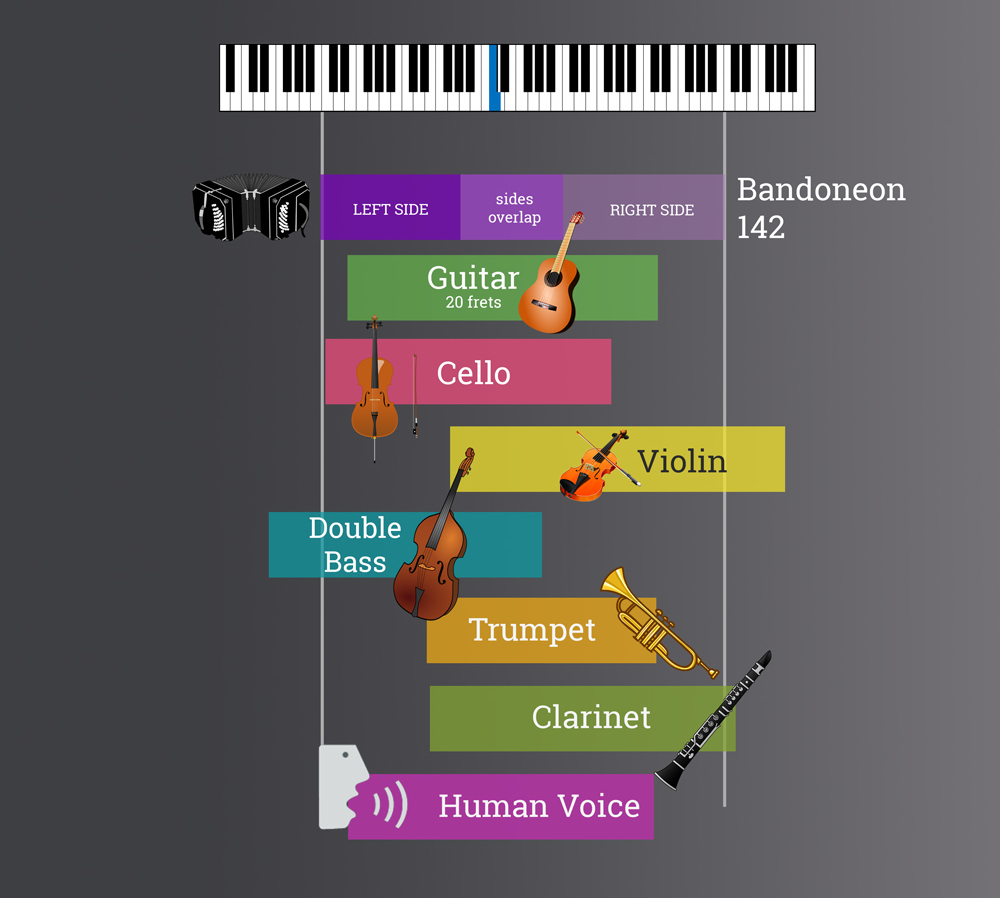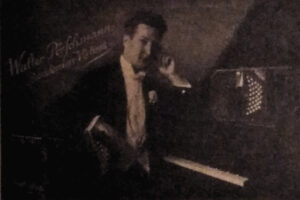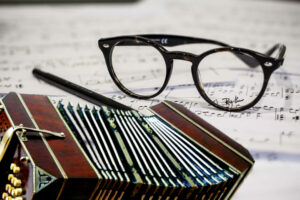
The Mystery of Bandoneon’s 442 Hz Tuning: Why?
Anyone familiar with the bandoneon often encounters the magical number: 442. This value represents the frequency in Hertz of the central A that serves as
Looking to learn more about the bandoneon and how it can be utilized in composition? Check out our article which delves into the unique history and characteristics of this versatile instrument, as well as offering tips and techniques for composers looking to incorporate it into their work. Discover the beautiful sound and possibilities of the bandoneon today!
Note: These specifications refer to a specific kind of bandoneon, the “142 Rheinische”, which is the standard bandoneon in tango and in other main genres. Other models may differ.
The bandoneon is a free reed instrument belonging to the Concertina family. It was invented in Germany in the mid-nineteenth century to play German folklore, but it gained great popularity in Argentina and Uruguay due to the tango.
The sound is produced by the movement of the bellows and the vibrations of 2 reeds for each note. In the bandoneon 142, the same key produces two different notes when opening (pulling) or closing (pushing) the bellows. This type of bandoneon is called bisonoric (or, diatonic, improperly). There are also unisonoric bandoneons (improperly called chromatic).
The bandoneon can play in all tonalities.
The bandoneon is a chromatic instrument with a total range of notes from C2 to A6.
There is a partial overlap of the 2 keyboards from A3 to A4.

The bandoneon is a polyphonic instrument. As it can be played with 2 hands and 4 fingers each, it permits up to 8 notes simultaneously in a chord. Some virtuosos can, in certain cases, play up to 5 notes with each hand.
Because of the chaotic layout of its keyboards it is possible to play chords made by very distant intervals with each hand. In addition to being able to play melodies accompanied by chords, the bandoneon is a counterpoint instrument: theoretically, it is possible to play up to four melodic lines simultaneously.
The bandoneon has sound characteristics that are similar to those of woodwind instruments. Composing for the bandoneon is similar to composing for a section of woodwinds, although the bandoneon is not a transposing instrument.
In the bandoneon, it is possible to play from (ppp) to (fff). In the older instruments the pianissimo could always be louder than a pianissimo in a modern instrument.
The change of volume intensity can be soft and progressive or sudden.
The two keyboards always play at the same volume because they are directly connected by the bellows.
The bandoneon is generally tuned with A=442 Hz. This is the most common option for tango because of its more brilliant sound in orchestra. In general, it is the standard tuning for any bandoneon 142.
The bandoneon’s staff is the same as for the grand piano.
The bandoneon is not a transposing instrument.
The composer can specify in the score when the bandoneon player should open or close the instrument. In general, this decision is left to the player.
When playing a note on the bandoneon 142, the characteristic sound is produced by the simultaneous vibration of two reeds at the distance of a perfect octave. A well-tuned bandoneon doesn’t produce a beat effect.
The sound of the bandoneon is very “dry”, with a quick attack and no sustain.
The sound of the left keyboard is slightly different from the right one due to a wooden “resonance” box from which the sound emanates. This gives the left keyboard a mellower and more nasal sound.
Some bandoneon players suggest that there is a significant difference in tone between the vintage instruments and modern instruments. This means that those who want to play a vintage sound typically use vintage instruments, similar to how guitar players prefer old Fender guitars to get that specific sound.
Tradicional:
Contemporary:
Examples of use in Cinema:
The most highly regarded brands of vintage instruments are Doble A and Premier (both manufactured by the same company, Alfred Arnold). ELA instruments are also considered excellent, although their sound is often considered less resonant due to their reed supports generally being made of aluminum instead of zinc, as in the case of the Doble A. Additionally, there are excellent instruments of German craftsmanship that are relatively unknown due to their rarity, such as the Birnstock.
All the vintage instruments were produced in Germany, and those produced before the 2WW are considered the best. Instruments produced during or after 2WW are of much lower quality. The massive production of vintage instruments ceased in the 1950s.
Nowadays, there are several manufacturers of excellent brand-new instruments. Among the most highly regarded are Baltazar Estol in Argentina, Heeju Oh in Germany/France, and Uwe Hartenahuer in Germany.

Anyone familiar with the bandoneon often encounters the magical number: 442. This value represents the frequency in Hertz of the central A that serves as

The month of March is associated with the bandoneon because on March 11th, 1921, Astor Piazzolla was born. However, in the same month, on March

A useful movement strategy to simplify chords’ sequence Welcome to this new article dedicated to the Bandoneon technique. In this article, I’ll talk about pivoting:

Building an Effective Fundamental Technique and Injury-Free Practice In this article (and in the video below) I’ll discuss about two fundamental aspects of the bandoneon

3 steps to make it happen! If you’ve ever considered learning the bandoneon as an adult, then this article is tailored just for you. I

Looking to learn more about the bandoneon and how it can be utilized in composition? Check out our article which delves into the unique history
We noticed you're visiting from Italy. We've updated our prices to Euro for your shopping convenience. Use United States (US) dollar instead. Dismiss